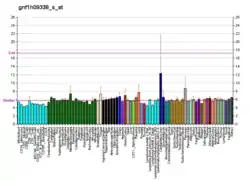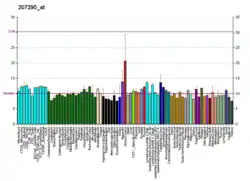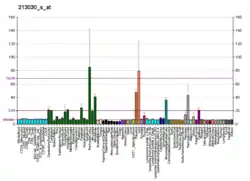PLXNA2
Plexin-A2 is a protein that in humans is coded by the PLXNA2 gene.[5][6]
This gene encodes a member of the plexin-A family of semaphorin co-receptors. Semaphorins are a large family of secreted or membrane-bound proteins that mediate repulsive effects on axon pathfinding during nervous system development. A subset of semaphorins are recognized by plexin-A/neuropilin transmembrane receptor complexes, triggering a cellular signal transduction cascade that leads to axon repulsion. This plexin-A family member is thought to transduce signals from semaphorin-3A and -3C.[6]
In some studies, the PLXNA2 gene is associated with schizophrenia.[7] and anxiety. PLXNA2 is a candidate gene for intellectual disability and possibly facial dysmorphism and congenital heart disease[8][9]
References
- GRCh38: Ensembl release 89: ENSG00000076356 - Ensembl, May 2017
- GRCm38: Ensembl release 89: ENSMUSG00000026640 - Ensembl, May 2017
- "Human PubMed Reference:". National Center for Biotechnology Information, U.S. National Library of Medicine.
- "Mouse PubMed Reference:". National Center for Biotechnology Information, U.S. National Library of Medicine.
- Maestrini E, Tamagnone L, Longati P, Cremona O, Gulisano M, Bione S, Tamanini F, Neel BG, Toniolo D, Comoglio PM (Mar 1996). "A family of transmembrane proteins with homology to the MET-hepatocyte growth factor receptor". Proc Natl Acad Sci USA. 93 (2): 674–8. Bibcode:1996PNAS...93..674M. doi:10.1073/pnas.93.2.674. PMC 40111. PMID 8570614.
- "Entrez Gene: PLXNA2 plexin A2".
- "Gene Overview of All Published Schizophrenia-Association Studies for PLXNA2". Schizophrenia Research Forum. Archived from the original on 21 February 2009.
- Altuame FD, Shamseldin HE, Albatti TH, Hashem M, Ewida N, Abdulwahab F, Alkuraya FS (July 2021). "PLXNA2 as a candidate gene in patients with intellectual disability". American Journal of Medical Genetics. Part A. 185 (12): 3859–3865. doi:10.1002/ajmg.a.62440. PMID 34327814. S2CID 236516392.
- Wray NR, James MR, Mah SP, Nelson M, Andrews G, Sullivan PF, et al. (March 2007). "Anxiety and comorbid measures associated with PLXNA2". Archives of General Psychiatry. 64 (3): 318–26. doi:10.1001/archpsyc.64.3.318. PMID 17339520.
Further reading
- Negishi M, Oinuma I, Katoh H (2005). "Plexins: axon guidance and signal transduction". Cell. Mol. Life Sci. 62 (12): 1363–71. doi:10.1007/s00018-005-5018-2. PMID 15818466. S2CID 32299864.
- Seki N, Ohira M, Nagase T, et al. (1998). "Characterization of cDNA clones in size-fractionated cDNA libraries from human brain". DNA Res. 4 (5): 345–9. doi:10.1093/dnares/4.5.345. PMID 9455484.
- Tamagnone L, Artigiani S, Chen H, et al. (1999). "Plexins are a large family of receptors for transmembrane, secreted, and GPI-anchored semaphorins in vertebrates". Cell. 99 (1): 71–80. doi:10.1016/S0092-8674(00)80063-X. PMID 10520995. S2CID 17386412.
- Nakayama M, Kikuno R, Ohara O (2003). "Protein–Protein Interactions Between Large Proteins: Two-Hybrid Screening Using a Functionally Classified Library Composed of Long cDNAs". Genome Res. 12 (11): 1773–84. doi:10.1101/gr.406902. PMC 187542. PMID 12421765.
- Strausberg RL, Feingold EA, Grouse LH, et al. (2003). "Generation and initial analysis of more than 15,000 full-length human and mouse cDNA sequences". Proc. Natl. Acad. Sci. U.S.A. 99 (26): 16899–903. Bibcode:2002PNAS...9916899M. doi:10.1073/pnas.242603899. PMC 139241. PMID 12477932.
- Clark HF, Gurney AL, Abaya E, et al. (2003). "The Secreted Protein Discovery Initiative (SPDI), a Large-Scale Effort to Identify Novel Human Secreted and Transmembrane Proteins: A Bioinformatics Assessment". Genome Res. 13 (10): 2265–70. doi:10.1101/gr.1293003. PMC 403697. PMID 12975309.
- Ota T, Suzuki Y, Nishikawa T, et al. (2004). "Complete sequencing and characterization of 21,243 full-length human cDNAs". Nat. Genet. 36 (1): 40–5. doi:10.1038/ng1285. PMID 14702039.
- Gerhard DS, Wagner L, Feingold EA, et al. (2004). "The Status, Quality, and Expansion of the NIH Full-Length cDNA Project: The Mammalian Gene Collection (MGC)". Genome Res. 14 (10B): 2121–7. doi:10.1101/gr.2596504. PMC 528928. PMID 15489334.
- Kimura K, Wakamatsu A, Suzuki Y, et al. (2006). "Diversification of transcriptional modulation: Large-scale identification and characterization of putative alternative promoters of human genes". Genome Res. 16 (1): 55–65. doi:10.1101/gr.4039406. PMC 1356129. PMID 16344560.
- Mah S, Nelson MR, Delisi LE, et al. (2006). "Identification of the semaphorin receptor PLXNA2 as a candidate for susceptibility to schizophrenia". Mol. Psychiatry. 11 (5): 471–8. doi:10.1038/sj.mp.4001785. PMID 16402134.
- Fujii T, Iijima Y, Kondo H, et al. (2007). "Failure to confirm an association between the PLXNA2 gene and schizophrenia in a Japanese population". Prog. Neuropsychopharmacol. Biol. Psychiatry. 31 (4): 873–7. doi:10.1016/j.pnpbp.2007.01.027. PMID 17346868. S2CID 46003583.






